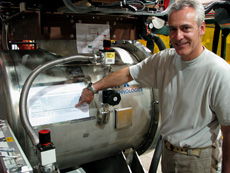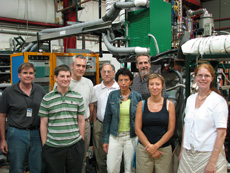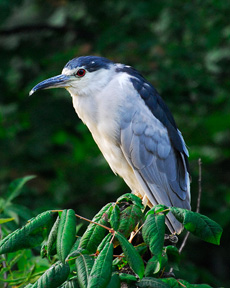|
Tuesday, Aug. 19
3:30 p.m.
DIRECTOR'S COFFEE BREAK - 2nd Flr X-Over
THERE WILL BE NO ACCELERATOR PHYSICS AND TECHNOLOGY
SEMINAR TODAY
Wednesday, Aug. 20
3:30 p.m.
DIRECTOR'S COFFEE BREAK - 2nd Flr X-Over
4 p.m.
Fermilab Colloquium - Auditorium (NOTE LOCATION)
Speaker: R. Tenchini, University of Pisa
Title: Road to Discovery: LHC Commissioning and Early Physics Analyses (in conjunction with the Hadron Collider Physics Summer School)
Click here for NALCAL,
a weekly calendar with links to additional information. |
Tuesday, August 19
- Golden broccoli & cheese
- Southern style fish sandwich
- Coconut crusted tilapia
- Spaghetti w/turkey meat sauce
- La Grande sandwich
- Assorted slice pizza
- Chicken fajitas
Wilson Hall Cafe Menu |
|
Wednesday, Aug. 20
Lunch
- Shrimp & pasta salad
- Cherry turnovers
Thursday, Aug. 21
Dinner
- Fresh tomato, mozzarella cheese with a basil dressing
- Grilled lamb chops
- Mushroom risotto
- Lemon sorbet with summer fruits
Chez Leon Menu
Call x4598 to make your reservation. |
|
|
ArgoNeuT sees first events

Flavio Cavanna points at an image of the first ArgoNeuT tracks, taped to the detector. Click on the image to see a close-up of the first raw data, which show a cosmic-ray event.
The liquid-argon program at Fermilab is moving ahead. Less than a week after the liquid-argon electronics test station recorded its first cosmic-ray events (see Fermilab Today, Aug. 13, 2008), the Argon Neutrino Test collaboration reported the observation of its first events at Fermilab.
"We started filling the detector with liquid argon on Monday, and by Saturday [Aug. 9] we had the first events," said ArgoNeuT spokesperson Bonnie Fleming, Yale University. "It's gone very well. So far, all systems look quite good."
Flavio Cavanna, of the University of L'Aquila, Italy, Ornella Palamara and Maddalena Antonello, from Gran Sasso National Laboratory, were the people working on the ArgoNeuT detector when it revealed the first cosmic-ray interactions. This team, which also works on the ICARUS experiment in Italy, came to Fermilab at the end of July to share its experience in starting up liquid-argon detectors.
"People were thinking this technology is black magic. But it's more like learning to drive a new car. You need to adjust the seat, point the mirrors in the right direction," said Cavanna, who worked with Fermilab's Andy Lathrop on starting up the cryogenics system. "The liquid-argon technology is more than reliable."
The ArgoNeuT detector relies on a time projection chamber filled with liquid argon to detect the tracks of charged particles. The chamber is about 3 feet long and 1.5 feet wide and high. Collaboration members at Michigan State University developed its electronics.
Later this year, the collaboration will move the detector into the NuMI/MINOS tunnel at Fermilab to measure the interaction of muon neutrinos with argon. The result will add to the analysis of neutrino data collected by ICARUS as well as future liquid-argon detectors.
"It's a big step for the technology of liquid-argon detectors in the U.S.," said Mitch Soderberg, who worked on setting up the detector in the Proton Assembly Building. "We're gaining the experience and knowledge necessary to build bigger detectors that can help answer some of the open questions about neutrinos."
To learn more about the ArgoNeuT experiment, read this article in the August issue of symmetry.
-- Kurt Riesselmann

Members of the ArgoNeuT team gather in front of their detector in the Proton Assembly Building. Later this year, the collaboration will move its detector into the NuMI/MINOS tunnel to record neutrinos.
|
A giant astronomical survey completes its mission: A new mission begins
From Sloan Digital Sky Survey,
Aug. 15, 2008
CHICAGO -- After a decade of construction and eight years of operation (SDSS-I, 2000-2005; SDSS-II, 2005-2008), the Sloan Digital Sky Survey (SDSS) completed its observations in mid-July and will release its final data set to the public in October. SDSS-III, a six-year program composed of four new surveys, has now begun, using the same telescope.
"I'm glad we didn't know at the beginning how hard it would be and how long it would take," said SDSS Project Scientist Jim Gunn, the Princeton astronomer who has guided the project since its inception. "But now that we've finally accomplished what we set out to do, and much more besides, it seems worth all the effort and all the headaches along the way."
Using a dedicated 2.5-meter diameter telescope equipped with two specialized instruments -- a 125-Megapixel digital camera and spectrographs that observe 640 stars and galaxies at a time -- SDSS has completed its original goals by making deep, multi-color images covering more than one-quarter of the sky and measuring the distances to nearly one million galaxies and over 100,000 quasars, thus creating the largest ever 3-dimensional maps of cosmic structure.
"What amazes me is the huge range of the discoveries that have come from SDSS data," said SDSS-II Director Richard Kron, an astronomer at the University of Chicago and Fermilab. "We designed it primarily as a survey to map the distribution of galaxies and quasars, but it's also had a huge impact on the study of stars, the structure of our own Galaxy, and even solar system objects."
Those achievements are being celebrated this weekend at an international symposium titled "The Sloan Digital Sky Survey: Asteroids to Cosmology," hosted by the Kavli Institute for Cosmological Physics at the University of Chicago. In more than 80 presentations, astronomers from around the globe will describe new discoveries about stars, galaxies, and the cosmos, from the SDSS and from some of the other ambitious surveys that it helped inspire.
Read more
|
|
|
Hadron Collider School
 |
| Pier Oddone |
We are one week into this year's Hadron Collider School, where some 145 advanced graduate students and post-docs from 25 countries are learning about all areas of collider physics. The Hadron Collider School is a cooperative venture between Fermilab and CERN. The first school was held in 2006 at Fermilab. It was followed by an equally successful school at CERN in 2007 and returned to Fermilab this year. The students are both theorists and experimentalists, and the lecturers are some of the major contributors to the development of collider physics throughout the world. Everyone who has come into contact with this year's students comments on their lively and excellent questions during lectures and the discussion sessions that follow. The latter go well into the evenings, through and after dinners. My hopes for particle physics become unbounded when I see the vitality of this large group of young scientists, who are motivated and eager to tackle the physics adventures that lie ahead.
We are living in a special moment of suspense, just before the opening of a huge new domain of physics at the LHC. In the meantime, from the operation of the accelerator to the production of physics papers, the Tevatron is having its special moment, running like a well-oiled machine. DZero and CDF submitted an astounding number of results to the recent ICHEP 2008 conference, more than 100 in total. Many Tevatron analyses are now mature and use the most advanced methods to squeeze every drop of information from the data. The physics projections for the LHC, together with the many physics analyses of real collider data from the Tevatron, are the perfect backdrop for this year's school.
So far, we understand all of the new Tevatron results in the context of the Standard Model. For phenomena beyond the Standard Model, at least up to the energy of the Tevatron, nature seems to guard its secrets extremely well. Enter the LHC. Our expectation and fervent hope is that some spectacular new phenomena will appear. It would be ideal if these new phenomena were so obvious that they did not require a huge analysis effort to claim a discovery. That has happened before. For example, when the J/Psi was observed at the Stanford Positron Electron Accelerating Ring, the claim of a major discovery was made within a couple of days of its first observation. We cannot count on being so lucky. Quantum chromodynamics (the strong force or QCD) will produce huge backgrounds for many possible discoveries. Sophisticated techniques to uncover those discoveries may be required from the very beginning. The students that we prepare in this summer's Hadron Collider School will be well-prepared to tackle this challenge.
|
Night heron an early bird

AD's Greg Vogel took this photo of a black crowned night heron resting near the wooden bridge on the path to the Lederman Center at 6:30 a.m. on Thursday, Aug. 14.
|
|
Have a safe day!
Monthly leave sheet due Wednesday
August monthly leave sheets are due in Payroll by 10 a.m. on Wednesday, August 20, 2008.
Salary Review FY09 Q&A available
Salary Review FY09 Questions & Answers are now available online (download Powerpoint) under "What's New in WDRS."
Blood Drive Aug. 26, 27
Fermilab's next blood drive will take place from 8 a.m. - 2 p.m. on Aug. 26 and 27. Heartland Blood Centers will take donations in the Wilson Hall Ground Floor NE Training Room. To ensure enough BBQ sets and aprons are aviailable for all who donate, appointments are encouraged, although walk-ins are welcome. Schedule appointments online or call Diana at x3771 or Margie at x5680.
Retiree medical plan meeting today
Effective Oct. 1 the cost of the Fermilab retiree medical plan
will change. All retirees and employees will receive a letter with the
details of the changes. The information is also available online as a pdf
file. The Benefits Office will hold two meetings to answer questions regarding the
changes: Tuesday, Aug. 19, at 2 p.m. in Curia II, and Thursday, Sept. 11,
at 2 p.m. in One West.
Scottish Country Dancing Tuesday
Scottish Country Dancing will meet in Ramsey Auditorium Tuesday, Aug. 19. Instruction begins at 7:30 p.m. and newcomers are always welcome. Most dances are fully taught and walked through, and you do not need to come with a partner. For more information call (630) 840-8194 or (630) 584-0825 or e-mail.
Additional Activities
|
|